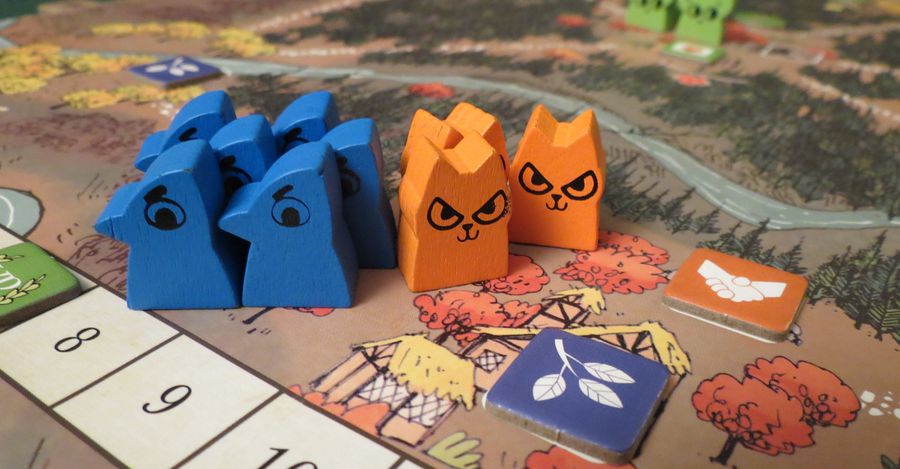
Welcome back to Tabletop Tastes: My favorite flavors in board games! This is a series where we spend each episode diving deep into an essential element of game design. For hobbyist gamers, this series will help you to explore your own tastes in the hobby and perhaps discover your next favorite game that fits those tastes. For game designers, this series will offer you more tools to add to your utility belt and metrics to measure your projects by.
If you missed the previous episode, then go on and check out Tabletop Tastes #11: Filling Turns.
Shameless Pride and Questionable Diets
Have you ever been unreasonably proud of an accomplishment that you should instead be ashamed of?
For me, these pitifully proud accomplishments would include things like breaking 150 hours of playtime on The Legend of Zelda: Breath of the Wild, eating some form of ice cream every day for a week straight, and being only 6 minutes late to work.

Another shameless accomplishment that I remember fondly occurred during my years in Junior High School. It was seemingly a day just like any other until I found myself snacking on s’mores ice cream late in the evening and realized something truly magical had happened that day: I had consumed FOUR different kinds of s’mores flavored products in a single day. Kelloggs s’mores cereal for breakfast, a s’mores Chewy granola bar for a snack, a s’mores Pop Tart after school, and s’mores ice cream for dessert. Now before you go judging 14-year-old Nick, you need to understand that s’mores cereal contains ELEVEN vitamins and minerals. I’m sure that completely changes how this all looks to you…
So while I got away with such a sweet treat feat back in my glory days, one can presume that this diet would quickly wreck an average human’s health and energy, even after only a few days. I still love me a good s’mores flavored treat, but I try to keep a more balanced diet from one day to the next. It’s amazing how different your body can feel when eating constant junk food compared to fresh, hearty, healthy food.
Cooperative Design – A Balancing Act
Balance is likewise important in board games, where an experience can quickly feel wrecked by a lack thereof. Last episode, we talked about how Pandemic provides filling turns while another Pandemic-like game, Flash Point, struggles to satiate. Well, Pandemic is again a great example to explore within the context of balance, particularly when compared with its younger sibling, Forbidden Desert.
Forbidden Desert has a combination of a fun theme and simple rules that plants itself firmly in the family-friendly, gateway game category. It brings out the theme well as players thirstily, blindly, & desperately search the desert in a scramble to assemble a rescue machine before time runs out.

With this Forbidden series, the designer, Matt Leacock, shamelessly recycles the mechanisms of his legendary classic, Pandemic, to morph the system into a different theme. Of course many cooperative designers do (and rightly should) take inspiration from Pandemic, so you can’t blame Mr. Leacock for doing this very thing.
The issue with Forbidden Desert is that it copies Pandemic’s recipe but leaves out one critical ingredient: difficulty balance. In Pandemic, the game gets increasingly harder as time passes because more infection cards are drawn per turn. This is mitigated by the cycling infection cards being predictable and by players being able to get stronger and increase their turn efficiency: they place buildings, eradicate diseases, and increase the cards in their hands. Meanwhile, in Forbidden Desert, more “bad” cards per turn are drawn as the game progress, but players are not able to proportionally mitigate these problems.

Every experience that I’ve had playing Forbidden Desert follows the same course of multiplying piles of sand tokens that increasingly bog down each player’s turn effectiveness until they are finally put out of their misery in crushing defeat. With Forbidden Desert, what you end up with is a poor Pandemic copy-cat that much more frequently spirals out of control because of luck of the draw. In Pandemic, you can usually blame yourselves for losing the game. In Forbidden Desert, you’re usually blaming the game for losing the game; and more often than not, you’re losing the game.

Balance for Blandness
I’m perfectly fine with punishing games and challenging experiences, but Forbidden Desert just feels broken and unbalanced when compared to the superior Pandemic. Yet there is something to be said for having too much balance in a diet—devoid of indulgent entrees or divine desserts—or too much fairness in a game. Cole Werhle explains this issue best in his GDC talk about Kingmaking, his Ludology podcast interview about fairness, and his Dicebreaker interview about prioritizing “good” over “fun” in game design.
In short, games that are devoid of “unfair” moments are games that frequently lack memorable, dramatic, and interesting experiences. Cole explains further:
“So a lot of event decks, the more you play, the more they are in development, they get milder and milder and milder. Because what they’re doing is they’re optimizing for fun and they’re optimizing against ‘feel bad’ moments.
“From my own design aesthetic, both of those things are horrible things to optimize for. Whenever I am working at Leder, we have friends in or people are visiting or working on games, if ever people start talking about ‘fun’ or ‘feel bad’, I’m like, ‘No, you can’t use those words.’ Because we’re not trying to make the game fun. We’re trying to make the game good. So ‘fun’ to me is this word that doesn’t really mean anything. Games have this massive emotional range – why would you want to make the game just about the giggles? You could do that too but, when you’re optimizing for it, you’re going to remove a lot of the character of the project.”
Dicebreaker interview with Cole Werhle

The Merits of External Balance
So how do games keep healthy balance in harmony with dynamic character? Cole’s most famous design, Root, is a great place to look. This woodland war between deeply asymmetric creatures is an emotional roller coaster packed to the brim with overpowered maneuvers and unfair situations. Despite this frequently unstable game state, the design allows for players to keep runaway leaders in check or boost lagging losers upward by forming enemies and forging alliances. Root puts its own balance into the hands of the players and allows them to dictate the scales of favor. The beauty of a highly interactive game is that internal balance (within the design and rules) can move to the back seat and let external balance (player influence and interaction) do the driving.
One game that I’ve found to severely lack and desperately need external balance is Tapestry. During our first few plays with it, we had a blast igniting its many combotastic chain-reactions that result from the endless combinations of asymmetric Civilizations, unique tapestry cards, diverse technology cards, and varied advancement tracks. Yet the cracks began to show as these combos proved to be highly variable in their effectiveness and all too dependent upon luck-of-the-draw. Furthermore, the design teases players with the idea of interaction on the large central map of the board yet sucks the bones of the area control mechanism dry until it feels like a crumbling afterthought.

Imagine what a truly dynamic map could do to mend this seemingly broken design… A map where wars and alliances matter and lucky runaway combos can be kept in check by crafty adversaries. The thought of what might have been saddens me for a game that has so much going for it. I ultimately found that the more I consumed Tapestry, the more it made me feel sick to my stomach and long for more substantial games. Much like an all s’mores diet, it fails to provide the proper balance of nutrients that my hobbyist cravings demand.
Of course, something as potent as a sugar infused s’mores feast can hit the spot when properly timed and expected.
Tune in next time for Tabletop Tastes Episode 13: Purposefully Potent Meanness.
Other great games that contain balanced diets:
- Balanced strategy games: 7 Wonders, 7 Wonders Duel, Concordia, Brass: Birmingham, Beyond the Sun, Babylonia.
- Balanced cooperative games: The Crew: The Quest for Planet Nine, Horrified, Gloomhaven: Jaws of the Lion, The Mind, Sprawlopolis.
- Games with heavy external balance: Pax Pamir (Second Edition), Inis, Tammany Hall, Cosmic Encounter, Lords of Vegas.
What games have you found to be finely balanced? Share with us in the comments below!

Article written by Nick Murray. To follow his designs as they come to fruition, subscribe to our newsletter and follow Bitewing Games on social media!




My experience with Forbidden Desert could not be more different from yours. Every time I’ve played it, it’s come down to a knife’s edge. It always, *always,* feels like we’re dead…until someone figures out an ingenious way to chain together character abilities and equipment cards that will let us escape by the skin of our teeth. I’m extremely impressed that it manages to be such a close game every single time. And I love that that it always makes me think we’re going to lose even though we end up winning the majority of the time. We get to have the “spectacular miracle victory” experience almost every time we play, and somehow it never stops feeling like “I can’t believe we won!”
I think we came one turn away from winning once. That was pretty wild. Usually we get wrecked, so it’s good to hear your experience is better. I do wonder if different player counts are easier/harder. We’ve always played at 4.